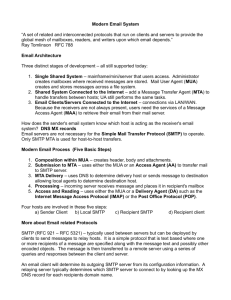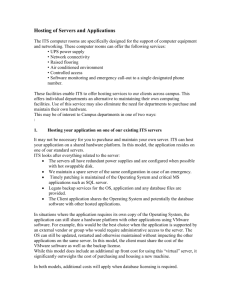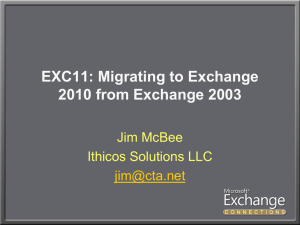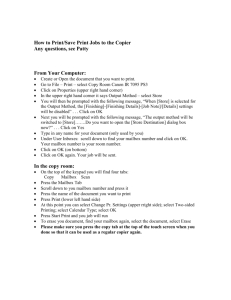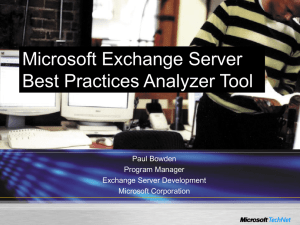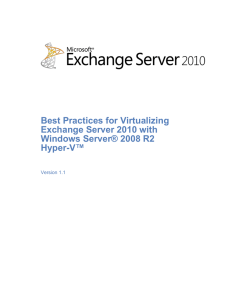Brown University Exchange 2003 Implementation
advertisement
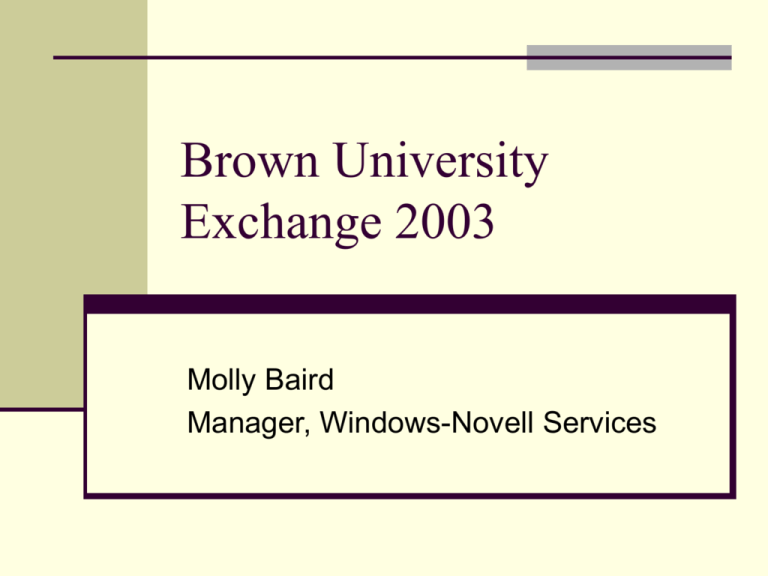
Brown University Exchange 2003 Molly Baird Manager, Windows-Novell Services Brown definitions CIS: Computing and Information services Provides central IT services, central helpdesk, SMTP + email services, file + print, DNS, networking DCC: Departmental Computing Coordinator Primary IT support person in Administrative and Academic departments. Focus on desktop and other client-side support issues Exchange: current statistics Mailboxes: 12,000 mailboxes migrated/added over 12 months 83% migrated (95% students migrated) Hardware: Two 2-node clustered Exchange mailbox servers Four load-balanced Exchange front-end servers (Outlook Web Access, IMAP, POP) 250 Gig total storage across both clusters Brown’s central Active Directory AD.brown.edu Departments CIS Groups/Lists Human Resources Workstations Engineering People Shared Accounts Faculty/Staff Students Systems & Services Exchange: internal routing Server 1 Clients Server 2 Two kinds of databases comprise an Exchange “information store” MAPI Store Stores content available to MAPI clients Internet Content Store Direct access by IMAP, POP, Outlook Web Access clients On-the-fly conversion of content when accessed by alternate client MAPI: Messaging Application Protocol Interface 2-way communication with Exchange information stores Changes in calendar, tasks, contacts, message folders Communicates with Global Catalog servers to retrieve Global Address List (GAL) Communicate with free/busy public folder to update calendar free/busy time Exchange collaboration: calendaring Shared auto-schedulable conference rooms and other resources View free/busy time of colleagues Configure permissions on calendar folder to permit others to see your personal calendar Delegate access to manage calendars Exchange collaboration: public folders Public Folders misnomer Departmental public folders Not replacement for file storage Vacation calendars Shared vendor contacts Shared lists Collections of project files Exchange collaboration: shared IDs Old model: shared password to access email in shared mailbox New model: managed by group access to shared mailbox Elimination of shared-password access Group access *can* be managed by DCCs if acceptable by shared mailbox sponsor CIS not needed to update access to shared mailbox Brown’s central Active Directory AD.brown.edu Departments CIS Groups/Lists Human Resources Workstations Engineering People Shared Accounts Faculty/Staff Students Systems & Services Exchange: SMTP mail routing Worldwide SMTP servers Exchange servers Other departmental Email servers Brown SMTP servers Brown legacy: “spraying” email SMTP from outside world Legacy Postoffce server Brown SMTP servers Yahoo Mail Hotmail Exchange: sizing Database size based on SLAs to recover single database based on current backup practices Many small databases on each Exchange server Corruption in single database affects only 300 – 400 faculty/staff --or--500 – 600 student mailboxes Exchange: maintenance Need for maintenance indicated in server syslogs Offline maintenance scheduled as needed Test maintenance outcome on test/recovery Exchange server Exchange: recovery Exchange is a transactional database Database activity logged in transaction logs in real-time Transactions later committed to database at a lower processor priority. Single database recovery Recover last full backup copy of online database Recovery and replay of successive incremental transaction-log backups offline Exchange: costs Permanent Staff costs FTE hired for migration and maintenance (me!) One-time Costs: Migration: 1 ½ FTE staff split between administrative and technical duties for 6 months License: Microsoft Core Campus CAL required License: OS and Exchange software: $11,000 HW: four front-end servers: $30,000 HW: Staff cluster: $60,000 HW: Student cluster: $60,000 HW: SAN/storage for clusters: $70,000 Provisioning changes: coincided with Provisioning overhaul Total one-time cost: $231,000 Total recurring cost: 1 FTE + MS Core CAL Exchange: 2000 – 2003 upgrade Outage of less than 60 minutes across all servers over a span of four weeks Performed by one full-time staff member Additional “functionality testing” by full-time desktop services staff Benefits: improved Outlook Web Access client improved recovery options increased IIS security Exchange: growth Add new back-end clusters and distribute mailboxes across new server(s) Increase mailbox quota size Exchange: what limits growth Current database sizes limited by aggressive SLAs Backup methods aren’t sufficient for growing enterprise data needs Eliminating “backup to tape” component will enable faster restores “why can’t I have a 1 Gig mailbox like Gmail?” Recovery of an entire server of 1-Gig mailboxes using today’s methods would take a month. Exchange @ Brown: questions? Molly_Baird@brown.edu 401-863-7218 http://cis.brown.edu/doc/email/


